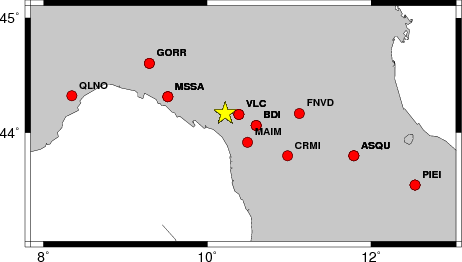
2013/06/22 01:56:12 44.168 10.217 10.5 3.4 Italy
USGS Felt map for this earthquake
SLU Moment Tensor Solution
ENS 2013/06/22 01:56:12:0 44.17 10.22 10.5 3.4 Italy
Stations used:
GU.GORR GU.MAIM IV.ASQU IV.BDI IV.CRMI IV.FNVD IV.MSSA
IV.PIEI IV.QLNO MN.VLC
Filtering commands used:
hp c 0.02 n 3
lp c 0.10 n 3
Best Fitting Double Couple
Mo = 8.51e+20 dyne-cm
Mw = 3.22
Z = 4 km
Plane Strike Dip Rake
NP1 250 50 -90
NP2 70 40 -90
Principal Axes:
Axis Value Plunge Azimuth
T 8.51e+20 5 340
N 0.00e+00 -0 250
P -8.51e+20 85 160
Moment Tensor: (dyne-cm)
Component Value
Mxx 7.40e+20
Mxy -2.69e+20
Mxz 1.39e+20
Myy 9.81e+19
Myz -5.06e+19
Mzz -8.38e+20
T ############
### ################
############################
##############################
##################################
#################---------------####
#############------------------------#
###########----------------------------#
########-------------------------------#
#######---------------------------------##
#####--------------- ----------------###
####---------------- P ---------------####
###----------------- --------------#####
#----------------------------------#####
#--------------------------------#######
#-----------------------------########
##------------------------##########
#####---------------##############
##############################
############################
######################
##############
Global CMT Convention Moment Tensor:
R T P
-8.38e+20 1.39e+20 5.06e+19
1.39e+20 7.40e+20 2.69e+20
5.06e+19 2.69e+20 9.81e+19
Details of the solution is found at
http://www.eas.slu.edu/eqc/eqc_mt/MECH.IT/20130622015612/index.html
|
STK = 70
DIP = 40
RAKE = -90
MW = 3.22
HS = 4.0
The waveform inversion is preferred.
The following compares this source inversion to others
SLU Moment Tensor Solution
ENS 2013/06/22 01:56:12:0 44.17 10.22 10.5 3.4 Italy
Stations used:
GU.GORR GU.MAIM IV.ASQU IV.BDI IV.CRMI IV.FNVD IV.MSSA
IV.PIEI IV.QLNO MN.VLC
Filtering commands used:
hp c 0.02 n 3
lp c 0.10 n 3
Best Fitting Double Couple
Mo = 8.51e+20 dyne-cm
Mw = 3.22
Z = 4 km
Plane Strike Dip Rake
NP1 250 50 -90
NP2 70 40 -90
Principal Axes:
Axis Value Plunge Azimuth
T 8.51e+20 5 340
N 0.00e+00 -0 250
P -8.51e+20 85 160
Moment Tensor: (dyne-cm)
Component Value
Mxx 7.40e+20
Mxy -2.69e+20
Mxz 1.39e+20
Myy 9.81e+19
Myz -5.06e+19
Mzz -8.38e+20
T ############
### ################
############################
##############################
##################################
#################---------------####
#############------------------------#
###########----------------------------#
########-------------------------------#
#######---------------------------------##
#####--------------- ----------------###
####---------------- P ---------------####
###----------------- --------------#####
#----------------------------------#####
#--------------------------------#######
#-----------------------------########
##------------------------##########
#####---------------##############
##############################
############################
######################
##############
Global CMT Convention Moment Tensor:
R T P
-8.38e+20 1.39e+20 5.06e+19
1.39e+20 7.40e+20 2.69e+20
5.06e+19 2.69e+20 9.81e+19
Details of the solution is found at
http://www.eas.slu.edu/eqc/eqc_mt/MECH.IT/20130622015612/index.html
|
The focal mechanism was determined using broadband seismic waveforms. The location of the event and the and stations used for the waveform inversion are shown in the next figure.

|
|
|
The program wvfgrd96 was used with good traces observed at short distance to determine the focal mechanism, depth and seismic moment. This technique requires a high quality signal and well determined velocity model for the Green functions. To the extent that these are the quality data, this type of mechanism should be preferred over the radiation pattern technique which requires the separate step of defining the pressure and tension quadrants and the correct strike.
The observed and predicted traces are filtered using the following gsac commands:
hp c 0.02 n 3 lp c 0.10 n 3The results of this grid search from 0.5 to 19 km depth are as follow:
DEPTH STK DIP RAKE MW FIT
WVFGRD96 1.0 100 30 -15 3.06 0.4742
WVFGRD96 2.0 100 30 -20 3.11 0.5303
WVFGRD96 3.0 80 40 -85 3.20 0.5955
WVFGRD96 4.0 70 40 -90 3.22 0.6318
WVFGRD96 5.0 75 40 -85 3.28 0.6148
WVFGRD96 6.0 75 45 -75 3.26 0.5736
WVFGRD96 7.0 85 50 -60 3.24 0.5193
WVFGRD96 8.0 95 65 -50 3.23 0.4848
WVFGRD96 9.0 100 65 -40 3.21 0.4593
WVFGRD96 10.0 105 65 -30 3.20 0.4401
WVFGRD96 11.0 105 65 -20 3.19 0.4239
WVFGRD96 12.0 110 65 -5 3.18 0.4097
WVFGRD96 13.0 110 65 0 3.18 0.3979
WVFGRD96 14.0 115 65 5 3.19 0.3868
WVFGRD96 15.0 115 65 15 3.21 0.3769
WVFGRD96 16.0 120 65 20 3.23 0.3708
WVFGRD96 17.0 120 65 25 3.24 0.3667
WVFGRD96 18.0 120 70 40 3.27 0.3637
WVFGRD96 19.0 120 70 40 3.28 0.3601
WVFGRD96 20.0 125 65 30 3.27 0.3552
WVFGRD96 21.0 125 65 40 3.28 0.3505
WVFGRD96 22.0 125 70 50 3.31 0.3495
WVFGRD96 23.0 125 70 50 3.32 0.3496
WVFGRD96 24.0 130 70 50 3.32 0.3503
WVFGRD96 25.0 130 70 55 3.34 0.3543
WVFGRD96 26.0 135 70 55 3.35 0.3605
WVFGRD96 27.0 135 70 50 3.35 0.3670
WVFGRD96 28.0 140 65 55 3.37 0.3728
WVFGRD96 29.0 140 65 55 3.38 0.3770
The best solution is
WVFGRD96 4.0 70 40 -90 3.22 0.6318
The mechanism correspond to the best fit is
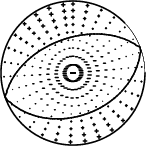
|
|
|
The best fit as a function of depth is given in the following figure:
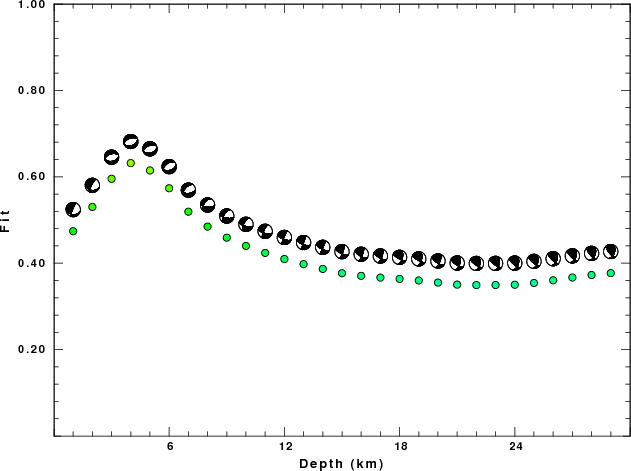
|
|
|
The comparison of the observed and predicted waveforms is given in the next figure. The red traces are the observed and the blue are the predicted. Each observed-predicted component is plotted to the same scale and peak amplitudes are indicated by the numbers to the left of each trace. A pair of numbers is given in black at the right of each predicted traces. The upper number it the time shift required for maximum correlation between the observed and predicted traces. This time shift is required because the synthetics are not computed at exactly the same distance as the observed and because the velocity model used in the predictions may not be perfect. A positive time shift indicates that the prediction is too fast and should be delayed to match the observed trace (shift to the right in this figure). A negative value indicates that the prediction is too slow. The lower number gives the percentage of variance reduction to characterize the individual goodness of fit (100% indicates a perfect fit).
The bandpass filter used in the processing and for the display was
hp c 0.02 n 3 lp c 0.10 n 3
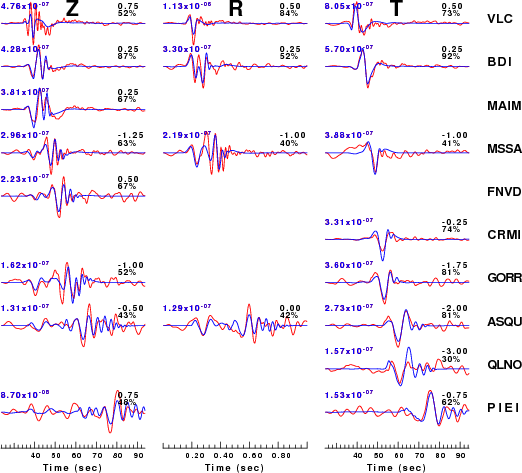
|
|
|
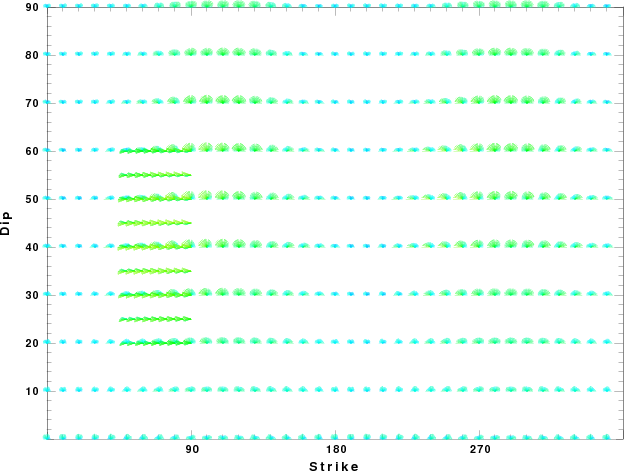
|
| Focal mechanism sensitivity at the preferred depth. The red color indicates a very good fit to thewavefroms. Each solution is plotted as a vector at a given value of strike and dip with the angle of the vector representing the rake angle, measured, with respect to the upward vertical (N) in the figure. |
A check on the assumed source location is possible by looking at the time shifts between the observed and predicted traces. The time shifts for waveform matching arise for several reasons:
Time_shift = A + B cos Azimuth + C Sin Azimuth
The time shifts for this inversion lead to the next figure:
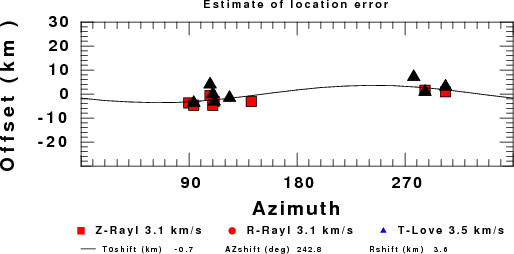
The derived shift in origin time and epicentral coordinates are given at the bottom of the figure.
The nnCIA used for the waveform synthetic seismograms and for the surface wave eigenfunctions and dispersion is as follows:
MODEL.01
C.It. A. Di Luzio et al Earth Plan Lettrs 280 (2009) 1-12 Fig 5. 7-8 MODEL/SURF3
ISOTROPIC
KGS
FLAT EARTH
1-D
CONSTANT VELOCITY
LINE08
LINE09
LINE10
LINE11
H(KM) VP(KM/S) VS(KM/S) RHO(GM/CC) QP QS ETAP ETAS FREFP FREFS
1.5000 3.7497 2.1436 2.2753 0.500E-02 0.100E-01 0.00 0.00 1.00 1.00
3.0000 4.9399 2.8210 2.4858 0.500E-02 0.100E-01 0.00 0.00 1.00 1.00
3.0000 6.0129 3.4336 2.7058 0.500E-02 0.100E-01 0.00 0.00 1.00 1.00
7.0000 5.5516 3.1475 2.6093 0.167E-02 0.333E-02 0.00 0.00 1.00 1.00
15.0000 5.8805 3.3583 2.6770 0.167E-02 0.333E-02 0.00 0.00 1.00 1.00
6.0000 7.1059 4.0081 3.0002 0.167E-02 0.333E-02 0.00 0.00 1.00 1.00
8.0000 7.1000 3.9864 3.0120 0.167E-02 0.333E-02 0.00 0.00 1.00 1.00
0.0000 7.9000 4.4036 3.2760 0.167E-02 0.333E-02 0.00 0.00 1.00 1.00
Here we tabulate the reasons for not using certain digital data sets
The following stations did not have a valid response files:
DATE=Tue Jul 2 09:39:44 CDT 2013